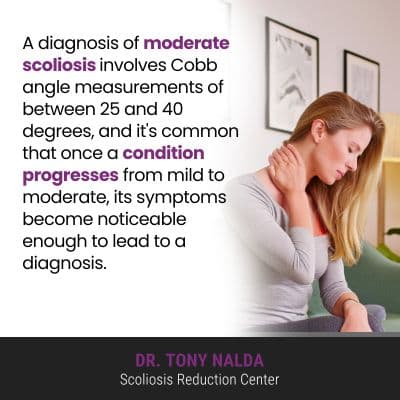There are a number of spinal conditions that involve a loss of healthy spinal curves, but as the leading spinal condition among school-aged children, scoliosis is highly-prevalent; in addition, scoliosis has some additional characteristics that set it apart. Continue reading to learn more.
Scoliosis degrees refers to a patient’s Cobb angle measurement which determines condition severity. In order to be considered a true scoliosis, an unnatural spinal curve has to bend to the side, twist, and have a minimum Cobb angle measurement of 10 degrees.
Scoliosis is a complex condition so let’s start with how it’s diagnosed.
Diagnosing Scoliosis
At one point, scoliosis screening was performed in schools across the United States, but that has since changed, and the early signs of scoliosis aren’t always easy to recognize.
Scoliosis can develop in any of the spine’s main sections, or in more than one as a combined scoliosis: cervical spine (neck), thoracic spine (middle/upper back), and the lumbar spine (lower back).
If scoliosis develops, an unnatural sideways curvature of the spine that also twists is present, and as a progressive condition, where a scoliosis is at the time of diagnosis doesn’t mean that’s where it will stay.
A scoliotic curve has to have a minimum Cobb angle measurement of 10 degrees; a patient’s degree of scoliosis is what determines condition severity.
A patient’s Cobb angle is determined during X-ray by drawing lines from the tops and bottoms of the curve’s most-tilted vertebrae, at its apex, and the resulting angle is expressed in degrees.
Part of diagnosing scoliosis involves further classifying conditions based on key patient and condition variables.
Conditions are classified to streamline the scoliosis treatment process and to inform the crafting and customization of treatment plans, including condition severity.
Condition Severity
Scoliosis isn’t a static condition; it’s progressive so its nature is to get worse over time, and as scoliosis progresses, it becomes more severe.
The only way to counteract the condition’s progressive nature is through proactive treatment that addresses the condition’s underlying structural nature.
Scoliosis ranges in severity from mild scoliosis to moderate scoliosis and severe to very-severe scoliosis, and this is the condition’s progressive line.
The degrees of scoliosis refer to its different severity levels, so let’s talk about what the different severity levels mean, particularly in terms of symptoms and treatment options.
Mild Scoliosis

A minimum Cobb angle measurement of at least 10 degrees is needed for an unnatural spinal curve to be diagnosed as scoliosis.
A Cobb angle measurement of between 10 and 25 degrees is diagnosed as mild scoliosis, and at this level, scoliotic curves are smaller and simpler to treat, and mild scoliosis isn’t associated with functional deficits.
When scoliosis is mild is precisely the time to start treatment because the more scoliosis progresses, the more difficult it gets to treat; in most cases, it’s more effective to proactively work towards preventing progression than it is to attempt to reverse its effects once they’re established.
If on the path of a traditional treatment approach for scoliosis, a diagnosis of mild scoliosis is commonly met with the recommendation to watch and wait for signs of continued progression, but as virtually all conditions are going to progress, this is wasting valuable treatment time.
In addition, as growth is the main trigger for progression, merely observing scoliosis in children can mean a growth spurt triggers progression, making it more complex to treat.
If on the path of a modern conservative treatment approach, a diagnosis of mild scoliosis would be met with early intervention; the benefits of early detection are only available to those who respond with proactive treatment.
The signs of mild scoliosis are subtle; in children, they can include subtle postural changes such as uneven shoulders and hips, and in adults, the main symptom of scoliosis is pain.
Moderate Scoliosis
A diagnosis of moderate scoliosis involves Cobb angle measurements of between 25 and 40 degrees, and it’s common that once a condition progresses from mild to moderate, its symptoms become noticeable enough to lead to a diagnosis.
Here at the Scoliosis Reduction Center®, most of my patients have moderate scoliosis because many times, the signs of mild scoliosis are too subtle for anyone, other than a specialist, to detect, and it’s not until progression occurs making symptoms more noticeable that a diagnosis is reached.
The postural changes associated with moderate scoliosis are more overt, and in addition to uneven shoulders and hips can include:
- Uneven shoulder blades
- The development of a rib cage arch
- An uneven waist line
- Arms and legs that appear to hang at different lengths
At this level of severity, changes to gait, balance, and coordination are also common as the body’s center of gravity is also disrupted.
In adults, the condition also involves postural changes, but the most-noticeable symptom is pain caused by compression, so at the moderate level, pain has likely increased alongside progression.
Compression and Pain
As the condition’s uneven forces disrupt the body’s overall symmetry, once skeletal maturity has been reached and the condition becomes compressive, compression of the spine and its surrounding muscles and nerves is the main cause of condition-related pain.
In children who are still growing, the constant lengthening motion of growth counteracts the compressive force of the unnatural spinal curve, which is why back pain isn’t a common part of childhood scoliosis.
Scoliosis pain can include back pain, muscle pain, and pain that radiates into the extremities due to nerve compression; nerve pain is often considered the worst form of back pain.
At the moderate level, bracing is often applied as a facet of treatment; in traditional treatment, bracing is limited and is the only form of treatment applied prior to a surgical recommendation when/if patients progress to become severe.
In conservative treatment, multiple types of treatment are applied as close to the time of diagnosis as possible: chiropractic care, physical therapy, corrective bracing, and rehabilitation.
Severe Scoliosis

Severe scoliosis has a Cobb angle of 40+ degrees, and very-severe scoliosis features large curves of 80+ degrees.
At the severe level of progression, symptoms are overt; in children, the asymmetry will be noticeable symptoms, and a prominent lean to one side is common in both children and adults.
In adults, pain can range, but at the severe level, pain can be chronic and get worse when natural age-related spinal degeneration comes into play with older adults.
At the severe level, if undergoing traditional treatment, this is when patients become surgical candidates, and this means spinal fusion surgery is recommended.
As scoliosis gets more severe, it becomes more complex to treat, and this is because the spine gets increasingly rigid with progression, making it less responsive to treatment, and also making it difficult for some patients to perform key therapeutic exercises as part of treatment.
Spinal fusion surgery can straighten a bent spine, but the way it does so, by removing spinal discs and fusing multiple vertebrae together into one solid bone, and attaching rods to the spine with screws, is contrary to the spine’s natural movement-based design.
A fused spine is weaker, more vulnerable to injury, less flexible, and more rigid.
For those undergoing conservative treatment, chiropractic care, physical therapy, scoliosis-specific exercises, corrective bracing, and rehabilitation can impact severe scoliosis on multiple levels.
To prevent severe scoliosis from becoming very severe scoliosis, proactive treatment that works towards counteracting the condition’s progressive nature is needed.
Conclusion
Scoliosis is diagnosed when an unnatural side-to-side curvature of the spine has developed, and the spine also twists, making it a 3-dimensional condition, and the minimum degree of scoliosis needed to reach a diagnosis is 10 degrees.
The different degrees of scoliosis refer to its severity levels of mild, moderate, severe, and very severe scoliosis.
As a progressive condition, the degrees of scoliosis increase with progression, meaning a patient’s Cobb angle measurement increases, and this means the size of the unnatural spinal curve is increasing, as are the condition’s uneven forces, and their effects.
The goal of traditional treatment is to stop progression, and the goal of conservative treatment is to correct scoliosis through a proactive and integrative treatment approach.
Traditional treatment doesn’t have an approach for addressing scoliosis while mild and is more about responding with surgery when/if a patient progresses into the severe classification.
Conservative treatment is proactive; it’s started as close to the time of diagnosis as possible as this is when scoliosis is going to be at its mildest and most responsive.
Traditional treatment doesn’t benefit from early detection because watching and waiting is commonly recommended at the mild level, but this can mean allowing scoliosis to progress unimpeded.
While we don’t know what causes most cases of idiopathic scoliosis to develop, we know it’s growth that makes it progress, so childhood scoliosis should be taken seriously at every degree and severity level.
Here at the Center, every degree of scoliosis is met with proactive treatment applied in the hopes of preventing progression, increasing condition severity, and the need for invasive surgical treatment in the future.




